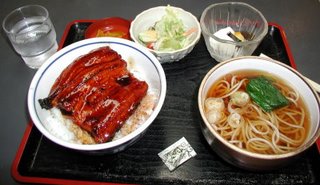 Doyo no Ushi no Hi 土用の丑の日 (which falls on July 28th this year) is a special mid-summer day devoted to eel-eating. The Japanese believe that eel helps the body combat heat-induced lethargy, prompting many older Japanese to join 500-metre queues to lunch at the city’s more famous eel houses. Expect demand to be particularly strong in central Tokyo, which is hotter than anywhere else in Japan. (Surprisingly, today is a rainy day of only 20℃ today, not the hottest day by any means.)
Doyo no Ushi no Hi 土用の丑の日 (which falls on July 28th this year) is a special mid-summer day devoted to eel-eating. The Japanese believe that eel helps the body combat heat-induced lethargy, prompting many older Japanese to join 500-metre queues to lunch at the city’s more famous eel houses. Expect demand to be particularly strong in central Tokyo, which is hotter than anywhere else in Japan. (Surprisingly, today is a rainy day of only 20℃ today, not the hottest day by any means.)鰻・ウナギ Unagi (eel) has been consumed in Japan since the 17th century. It used to be expensive food, but Unagi can be reasonably purchased nowadays. Unagi is rich in protein, calcium, vitamin A and E, and it's believed to give people stamina. So, unagi dishes are eaten the most during the hottest time of the year.
A common unagi dish is unagi no kaba-yaki (grilled eel). Prepared unagi meat (the main bone is removed) is skewered and grilled with sweet basting sauce. It's similar to teri-yaki. Most people in Japan buy unagi no kabayaki 蒲焼 at stores instead of making it themselves. Before eating kabayaki, you only have to reheat it with kabayaki sauce.
Kabayaki Sauce
INGREDIENTS:
1/2 cup soy sauce
1/2 cup mirin (sweet rice wine)
1/4 cup sugar
PREPARATION:
Pour all ingredients in a pan. Stir the mixture well. Put the pan on low heat and simmer for a couple of minutes. Remove from the heat and cool the mixture. Store the sauce in a clean bottle in the fridge.
When unagi is grilled over charcoals, the fat from unagi drips and burns, causing smoke. The smoke adds a great flavor to unagi. The smell coming from an unagi restaurant tends to invite many customers.
Commonly, unagi no kabayaki is served over plain rice as a main dish. It's called either una-juu ウナじゅう or una-don ウナどん. Clear soup (すいもの suimono) made from eel liver is called kimo-sui 肝すい and is served on the side.
No comments:
Post a Comment